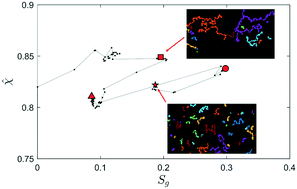Quantitative analysis of phase topology evolution during three-phase displacements in porous media†
Abstract
Multiphase flow in subsurface formations is the essence of aquifer remediation and petroleum recovery processes, where the phase mobilities are greatly influenced by phase topologies. Yet, flow models rarely utilize quantified phase topologies due to the limited availability of such data. Here, we conducted cutting-edge experiments using a micromodel together with a state-of-the-art automated imaging system to capture images with high temporal and areal resolution to characterize the phase topologies for three-phase displacements. The micromodel setup used in this study is a close replica of flow in natural rocks as the resulting three-phase saturation routes agrees well with results of rocks core floods. The injection sequence was repeated with different fluids to compare the effects of fluid properties on phase topologies. The resulting high fidelity images were used to calculate topological parameters such as Euler characteristic, the contact area between phases, flowing sub-phase, wetted rock surface area and saturations. We show that the trend of topological parameters helps to identify the dominant pore scale mechanisms. Furthermore, the developed workflow assists with verification of the microfluidic devices and mechanistic scaling of the microfluidic results to the desired condition.



 Please wait while we load your content...
Please wait while we load your content...